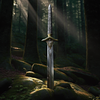Take a photo of a barcode or cover
The writing is excellent, the prose is rich and evocative without straying into flowery territory, and bits of semi-modern slang are woven into the dialogue in a way that feels really natural, which keeps conversations lively and avoids the stiltedness that some older novels can fall victim to.
There's a reason this series is one of the most recommended on lists of the greatest Arthurian tales. Anyone with an interest in Arthur and native British/Welsh history and culture who has already read the Warlord Chronicles and wants something in a similar vein would do themselves a favor reading this novel.
Like the game of chess, Arthurian legend is something I’ve always wished I enjoyed more and knew more about. On the surface, it would seem like exactly the sort of thing I would love, but for some reason I have yet to really savor it. One of those reasons might be a number of lackluster movie versions of Arthurian stories. These include 2004’s King Arthur (the only memory of which that I retain is a blue-painted, warrior-princess Keira Knightley, in generic, slow-motion battle scenes; hardly an image I’d choose to remember) and 1998’s Merlin television miniseries (no clear memories at all retained from that one). Another, and bigger, reason is the lingering bad taste from [a:Stephen R. Lawhead|28083|Stephen R. Lawhead|https://d.gr-assets.com/authors/1247321485p2/28083.jpg]’s Arthur series; the memory of those books has done more than anything else to keep me from reading anything else about Arthur. Yet I still feel somehow that I should enjoy Arthur, and so when the [a:Tolkien|656983|J.R.R. Tolkien|https://d.gr-assets.com/authors/1383526938p2/656983.jpg] group on Goodreads started a reading group for [a:Mary Stewart|15590|Mary Stewart|https://d.gr-assets.com/authors/1210367214p2/15590.jpg]’s [b:The Crystal Cave|82192|The Crystal Cave (Arthurian Saga, #1)|Mary Stewart|https://d.gr-assets.com/books/1400701147s/82192.jpg|1864677], I took that as my opportunity to dive into Arthur again.
Stewart’s series has long been on my list—because of its enduring popularity among fantasy fiction readers, and, especially, because my wife has loved the books for many years. Though I found the opening chapters a bit slow to get into (for some reason I found it difficult to follow Stewart’s particular style of description), by the middle I was hooked, and I finished the book feeling quite captivated by the story—and eager to move on to Book 2 in the series.
Reading this book as part of a Tolkien fan group, I was thinking as I read about how this storytelling relates to Tolkien’s style and interests, and whether Tolkien himself would have enjoyed Stewart’s writing. I think he might have. Like Tolkien, Stewart takes the reader to an ancient world that already has an ancient history stretching even further back. I liked the descriptions of fortresses and memorials that are in ruins at the time of Stewart’s story, and the weight of history that permeates her world. The ruined history visible in that world conveys a sense of impermanence, and possibly even hopelessness that any of the dreams and visions of a better world in the story’s present can ever be realized and endure. There is a heaviness of doom in Stewart’s story, and it reminds me most of Tolkien’s story of [b:Turin|22065602|The Children of Hurin|J.R.R. Tolkien|https://d.gr-assets.com/books/1399770032s/22065602.jpg|41396883], in which the narrative mostly follows one character, traveling the world, growing and maturing and acquiring skills, yet in the end helpless against the fate he is destined to live out. Thinking about Tolkien as I read The Crystal Cave, I also enjoyed Stewart’s detail of the blue mantle worn by Ygraine, which reminded me so much of the blue mantle that Faramir puts around Eowyn in [b:The Return of the King|18512|The Return of the King (The Lord of the Rings, #3)|J.R.R. Tolkien|https://d.gr-assets.com/books/1389977161s/18512.jpg|2964424]--one of my favorite images from that book.
I suspect that Tolkien would have been disappointed (as I was!) that the dragons in the pool under Vortigern's fortress turn out, in Stewart's version, to be merely symbolic, rather than real dragons. (For a great illustrated retelling of that part of the Merlin legend, I recommend [a:Jane Yolen|5989|Jane Yolen|https://d.gr-assets.com/authors/1209044511p2/5989.jpg]'s [b:Merlin and the Dragons|104923|Merlin and the Dragons|Jane Yolen|https://d.gr-assets.com/books/1348943016s/104923.jpg|1639646]).
The difficulty with writing about an ancient period of earth history is that it’s nearly impossible to avoid putting our own modern Western culture onto that earlier time. British culture at the time of Merlin and Arthur would likely look extremely foreign to us now, but the author has to find ways to get inside the story so that it communicates to us, while also making us think that we’re being taken directly back to that time with no interpreter needed. Stewart does a fair job of this. There are few “modern” intrusions that took me out of the story entirely, but her characters are in many ways modern Westerners, at once familiar to us even though clothed in different attire and set in a somewhat foreign locale. Overall, I was satisfied with the tone of the storytelling throughout.
This is Arthurian legend at its finest. I like the ones that start out with other characters than Uther and Ygraine and Arthur. This is Merlin as a child and learning as he goes who he is and what he is capable of. Each other main player is introduced pretty much one at a time.
I recognized some similarities in another book....well.... movie, Excalibur, that got me started down the Arthurian legend path. I suppose several are based on each other or at least Thomas Mallory's "LMorte d'Arthur". The author does write, in the afterward, where aspects of her story are derived. It's part of why I like Arthurian legend, fantasy, paranormal, all of that. So many possibilities to make a new story based on a central theme.
I can definitely recommend this book, series and author.

